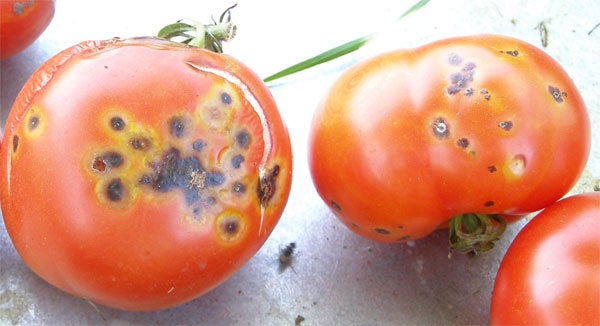UCF scientists have been awarded a $477,000 grant to develop a method of combatting a bacterium that attacks tomatoes and other crops.
The grant is part of a $5.2 million investment in nanotechnology research at 11 universities announced today by U.S. Agriculture Secretary Tom Vilsack.
The money from the U.S. Department of Agriculture’s National Institute of Food and Agriculture will fund three years of research by a team led by Swadeshmukul Santra of the University of Central Florida’s NanoScience Technology Center, as well as field trials to be conducted by University of Florida researchers Mathews Paret and Jeff Jones.
The disease, bacterial spot, is one of the most devastating for tomatoes and peppers, attacking plants in warm, moist areas around the world. Infection produces lesions on parts of the plant including its leaves and fruit. It can also lead to severe blighting of the foliage, rendering them more vulnerable to other fungal and bacterial pathogens.
When conditions are right for the spread of the disease, growers have seen their crop yields drop by more than half.
“The tomato industry has a major problem with this bacteria in Florida,” Santra said.
Options to manage the disease are limited. In the 1950s, growers began using the antibiotic streptomycin with some success. But strains of the bacteria developed resistance to the antibiotic and it lost its effectiveness. Growers have since been using a copper-based bactericide, but are now having the same problem: All strains of the bacterium in Florida are now tolerant of the standard copper treatment.
Santra and his team plan to use nanotechnology as a way of delivering copper inside the plant. They’ve developed a particle with a core housed inside a shell that can be delivered via a spray. The silica-based shell contains “engineered copper” nanoparticles small enough to pass through pores known as stomata on the leaves of the plant and move to the parts of the plants where the bacteria are located, attacking the bacteria from within.
“Our goal is that once you spray, this particle will mobilize to the stomata …and slowly release the copper,” Santra said. “Our idea is to deliver the bactericide inside so it stays there – it will be a locally systemic pesticide particle.”
Laurene Tetard, a NanoScience Technology Center researcher working with Santra, said the formulation is designed to deliver copper at levels much lower than the heavy concentrations now used, reducing the effect of copper accumulating in the environment. For that reason, new tools will be needed to monitor the treatments and their effects on plants. As part of the study funded by the USDA grant, Tetard will perform high-resolution subsurface imaging and spectroscopy to measure the distribution of the pesticide within plant tissues.
